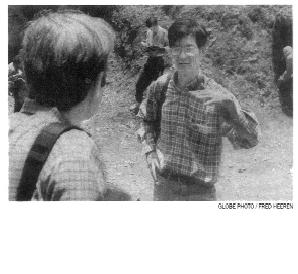“Challenging Fossil of a Little
Fish” (page 1)
- May 30, 2000
 | ||
Challenging Fossil of a Little Fish
By Fred Heeren
GLOBE CORRESPONDENT
CHENGJIANG, China — The fish-like
creature was hardly more than an inch long, but its discovery
in the rocks of southern China was a big deal. The
530-million-year-old fossil, dubbed Haikouella, had the barest
beginning of a spinal cord, making it the oldest animal ever
found whose body shape resembled modern vertebrates.
In the Nature article announcing his latest findings,
Jun-Yuan Chen and his colleagues reported dryly that the
ancient fish “will add to the debate on the evolutionary
transition from invertebrate to vertebrate.”
But the new fossils have become nothing
less than a challenge to the theory of evolution in the hands
of Chen, a professor at the Nanjing Institute of Paleontology
and Geology. Chen argues that the emergence of such a
sophisticated creature at so early a date shows that modern
life forms burst on the scene suddenly, rather than through any
gradual process. According to Chen, the conventional forces of
evolution can’t account for the speed, the breadth, and
one-time nature of “the Cambrian explosion,” a
geologic moment more than 500 million years ago when virtually
all the major animal groups first appear in the fossil record.
Rather than Charles Darwin’s
familiar notion of “survival of the fittest,” Chen
believes scientists should focus on something that better
explains why life evolved beyond bacteria. “Bacteria are
very successful,” Chen notes. In fact, complex life is
less capable of making adaptations.
If all we have to depend upon is chance
and competition, Chen says, then “complex, highly evolved
life, like the human, has no reason to appear. So why should
these chance mutations plan such complex types of
animals?” Chen proposed that an underlying principle of
“harmony” will someday explain what competition
cannot.
The debate over Haikouella casts
Western scientists in the unlikely role of defending themselves
against charges of ideological blindness from scientists in
communist China. Chinese officials argue that the theory of
evolution is so politically charged in the West that
researchers are reluctant to admit shortcomings for fear of
giving comfort to those who believe in a biblical creation.
“Evolution is facing an extremely
harsh challenge,” declared the Communist Party’s Guang Ming Daily last
December in describing the fossils in southern China. “In
the beginning, Darwinian evolution was a scientific theory
…. In fact, evolution eventually changed into a
religion.”
Taunts from the Communist Party
wouldn’t carry much sting, however, if some Western
scientists weren’t also concerned about weaknesses in
so-called neo-Darwinism, the dominant view of evolution over
the last 50 years.
“Neo-Darwinism is dead,” said
Eric Davidson, a geneticist and textbook writer at the
California Institute of Technology. He joined a recent
gathering of 60 scientists from around the world near
Chengjiang, where Chen had found his first fishlike impressions
of Haikouella five years ago.
But most Westerners at Chen’s
conference came to praise Darwin, not to bury him. The idea
that neo-Darwinism is missing something fundamental about
evolution is as scandalous to Americans as it is basic to the
Chinese.
However, despite their misgivings about
Chen’s “harmony” proposal — a
mysterious mix of scientific caution, Chinese philosophy, and a
decidedly non-Western lack of concern for Darwinian orthodoxy
— Western scientists have no choice but to go to China to
learn about the emergence of animal body plans, including that
of human forerunners.
Virtually all of today’s living
phyla — or major animal groups — make their first
impressions in the geologic period known as the Cambrian. And
Chengjiang, in the southern province of Yunnan, contains the
oldest and best preserved Cambrian fossils in the world.
Jun-Yuan Chen has co-authored half of all the papers on the
Chengjiang fauna.
Chen’s discovery of the earliest
chordate, named for the “notochord” that would
eventually form the vertebrate backbone, is, for him, but one
more piece in a puzzle that looks less and less like the
conventional picture of evolution through natural selection.
For Western paleontologists, Haikouella looks
like a breakthrough for understanding the origin of the human
lineage.
“It proves that the direct ancestor
of mankind already existed in the time of the Cambrian
explosion,” said German paleontologist Michael Steiner.
“Sort of instinctively, I felt I
should go and pay homage to this animal,” said another
scientist at the conference, Nicholas Holland, an authority on
primitive chordates at the Scripps Institution of Oceanography
in San Diego. “It’s the earliest known chordate
ancestor. This is going to be page one, two, three and four of
vertebrate texts.”
Chen enjoys seeing his fossils get the
attention. But to him, the big story is not that he has
discovered our earliest traceable ancestor, but that the
Cambrian explosion of new body plans is proving to be real, not
an illusion produced by an incomplete fossil record.
- more -